Andrés Cubas has joined Nîmes Olympique for €2.9m, which makes him Les Crocodiles’ most expensive signing of the 2020 summer transfer window as yet, prior to the reopening of the French transfer window on 15th August.
Cubas is a graduate of Boca Juniors’ academy and prior to his summer move to Nîmes, the 24-year-old central midfielder was plying his trade with Club Atlético Talleres in Argentina’s top tier.
In this tactical analysis piece, we will provide a scout report focusing on some of Cubas’ key strengths and weaknesses as a player. This tactical analysis piece will also look at Nîmes’ midfield and we will attempt to determine how the Paraguay international will fit into his new team’s tactics for the 2020/21 campaign.
Nîmes’ midfield
Before taking a look at Cubas, we are going to look at Nîmes Olympique and some of the notable elements of their midfield over the last two seasons since they were promoted to Ligue 1 for the 2018/19 campaign.
In their first season back in France’s top-flight since suffering relegation back in the 1992/93 season, Nîmes earned a respectable ninth-place finish in Ligue 1. In the summer that followed that campaign, their standout midfield player from the 2018/19 campaign, Téji Savanier, departed from the club as he made a €9.5m move to 2012/13 UEFA Champions League competitors Montpellier.
Les Crocodiles signed midfielders such as Lucas Deaux and Sidy Sarr that summer to fill the gap left in the team by the departure of Savanier, however, neither of the two players managed to have quite the same impact as the current Montpellier man.
Savanier provided an impressive 20 Ligue 1 goal contributions for Nîmes during the 2018/19 campaign, with 14 of those being assists – making him the top assist provider in France’s top tier for that campaign, making three more assists than PSG‘s Ángel Di María and helping Nîmes to bag an average of 1.5 goals per game in Ligue 1 that season.
In the 2018/19 Ligue 1 campaign, Savanier played more long passes (10.81), more through passes (1.26) and more passes to the final third (12.36) per 90 of any Nîmes player and during the most recent Ligue 1 season.
In the 2019/20 season, Savanier’s absence was undoubtedly felt as no Nîmes player managed to make more than four league assists and Les Crocodiles’ goals per game average dropped to 1.07.
It would be difficult to argue, given his impressive assists tally for the 2018/19 season, that the loss of Savanier didn’t have a significant impact on Nîmes ending the 2019/20 season eight places lower on the table than they ended the 2018/19 campaign and it may be fair to say that their struggles in front of goal last season may be the main reason behind their poorer performance than the season before.
Savanier possessed some impressive ability both on and off the ball that Nîmes benefitted from significantly during his time at their club. Firstly, it’s important to note that Nîmes are a side that enjoys playing on the counter-attack and are comfortable without the ball. During the 2018/19 season, Nîmes kept the fifth-lowest average possession percentage (46%) of any Ligue 1 side and in the 2019/20 campaign, they kept the joint-lowest average possession percentage (44.8%) of any team in France’s top tier.
While they like to play without the ball, Nîmes also like to win the ball back in the midfield and press relatively aggressively in the middle third of the pitch. Only six Ligue 1 sides made a higher percentage of their recoveries in the middle third of the pitch than Nîmes did (43%) during the 2019/20 campaign.
Nîmes’ midfielders are required to press quite aggressively in order to force turnovers in this area of the pitch and subsequently start counter-attacks. This highlights the pivotal role that Nîmes’ central midfielders have to play. They have to be well-rounded players, well versed in both the defensive and offensive aspects of the game. This role suited Savanier, who engaged in an average of 8.44 of Nîmes’ 69.81 defensive duels per 90 last season, with a 62.63% success rate.
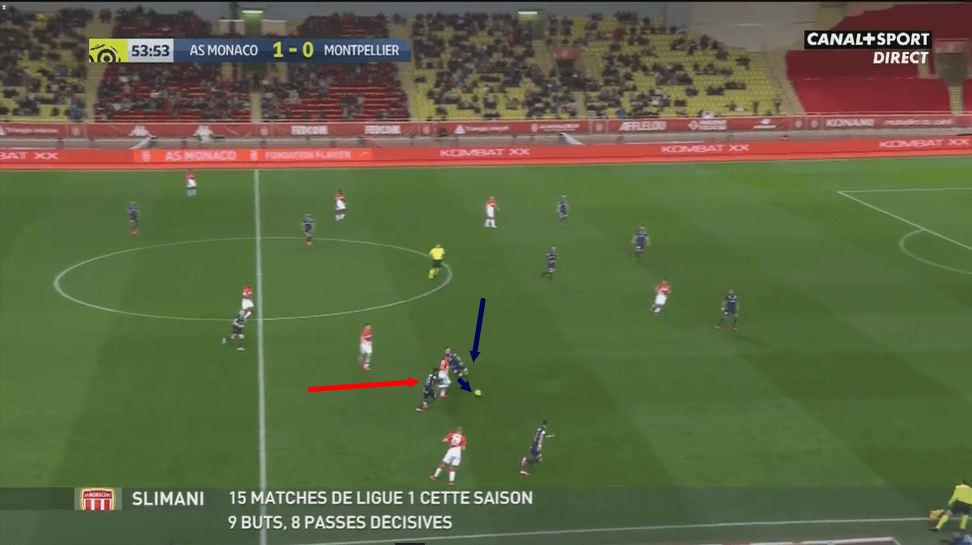
The image above, taken from his time at Montpellier in the 2019/20 season, shows us an example of Savanier’s willingness to engage the opposition aggressively in the middle of the park.
We can see that the midfielder roams from his central position slightly in order to engage the opposition ball-carrier as he begins to make strides into Savanier’s side’s half of the pitch and this is a trait of his that served him well during his time at Nîmes.
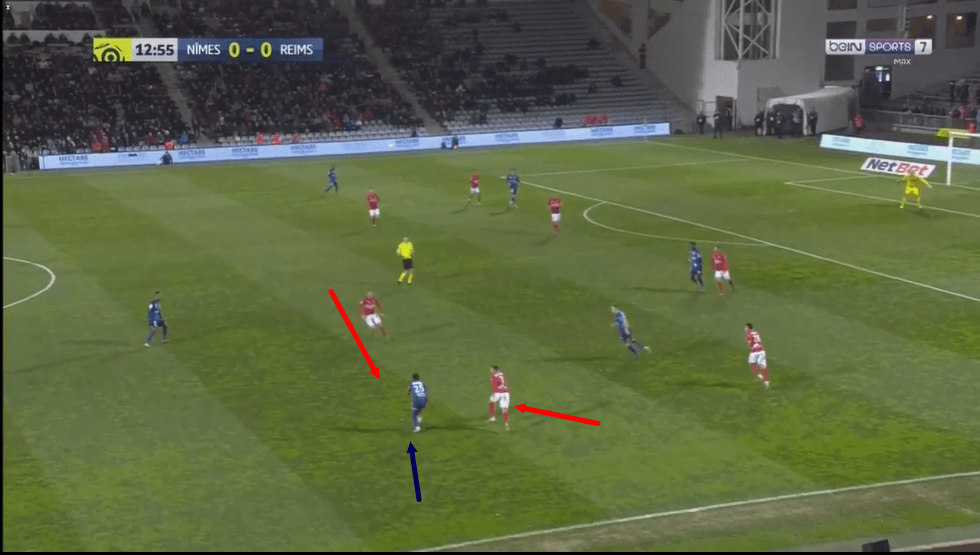
This next image provides us with an example of Nîmes’ aggressive midfield engaging the opposition ball-carrier in an attempt to win back possession and kickstart a counter-attack from the 2019/20 campaign.
As we can see this midfielder situated closer to the centre of the pitch is breaking out from the middle of the pitch to try and halt the dribble of this opposition winger and thanks to his speed and the help of his teammate, who we can also see applying some pressure here, he manages to successfully dispossess the ball-carrier.
As we can see, the ability to press aggressively is a trait that is valued highly by Nîmes for their central midfielders.
In possession, Nîmes’ central midfielders do have quite a bit of playmaking responsibility, as Savanier’s 14 assists during the 2018/19 season suggest. The central midfielders often have the responsibility of playing the final ball and setting their attackers through on goal, often from deep positions. Additionally, due to the team’s direct nature, the midfielders’ long passing ability and their ability to progress the ball into the final third are also key traits for Nîmes midfielders.
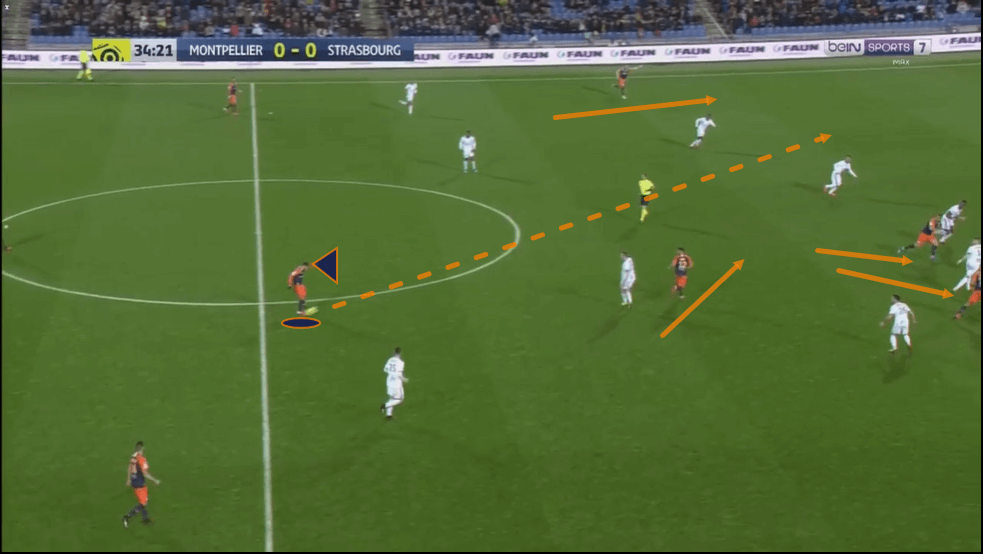
The image above, again, shows Savanier in action for Montpellier during the 2019/20 campaign and while this image isn’t taken from his time at Nîmes, it provides us with a clear example of what he is good at and why he was so successful during his time at Les Crocodiles.
Savanier likes to pick up the ball quite deep, just in front of the defence, and use his deep playmaking ability to set the attackers through on goal. He enjoys being on the ball in a deep position with plenty of runners ahead of him, as the image above shows us and this was a trait of his that made him well-suited for Nîmes during his time at the club.
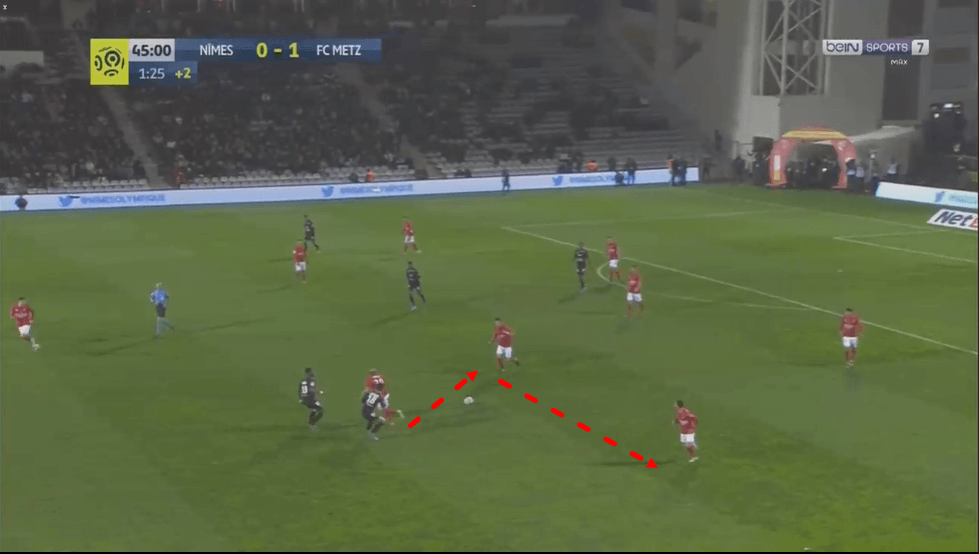
Just prior to the image above being taken, a Nîmes player managed to intercept a long-ball from an opposition player in the middle of the park and he subsequently controlled the ball and laid it back to a teammate positioned just in front of the defensive line – in the kind of position that Savanier would typically occupy.
While Nîmes’ attackers set off on their runs after this player receives the ball, he doesn’t take much time to look up or really consider playing a, potentially impactful, long-ball aimed in behind the opposition’s defensive line, instead opting to quickly play the ball out to the left-winger, who then takes it upon himself to carry the ball forward.
This passage of play highlights the deep-lying playmaking opportunities that can present themselves to Nîmes midfielders and while Savanier thrived in those situations, it may be fair to say that they have been lacking a bit in the playmaking department from deep since the 28-year-old joined Montpellier and a new midfield recruit would, ideally, be able to offer some more quality on the ball from deep to try and help the club to progress the ball into the final third more often and make up for the absence of Savanier.
Cubas’ defensive quality
Now that Nîmes’ midfield issues and the club’s requirements for a midfielder are clear, we will determine how this new signing may fit into their tactics for the 2020/21 season.
Firstly, off-the-ball, Cubas appears to tick all of the boxes for a Nîmes midfielder. He is quick, as well as being willing and capable of defending in any area of the pitch. Cubas is happy to defend aggressively and press high or out wide, as well as the centre and in deeper areas of the pitch.
During the 2019/20 campaign, Cubas engaged in more defensive duels (13.02) than any other player for Atlético Club Talleres, with a positive 64.44% success rate.
One notable difference between Talleres and Nîmes is that Talleres are a far more possession-based side than Les Crocodiles and so, Cubas’ defensive skills may have been tested more often in ways that they might not necessarily be tested at Nîmes. However, the Paraguay international displayed his ability to defend in a variety of different ways and in all zones of the pitch.
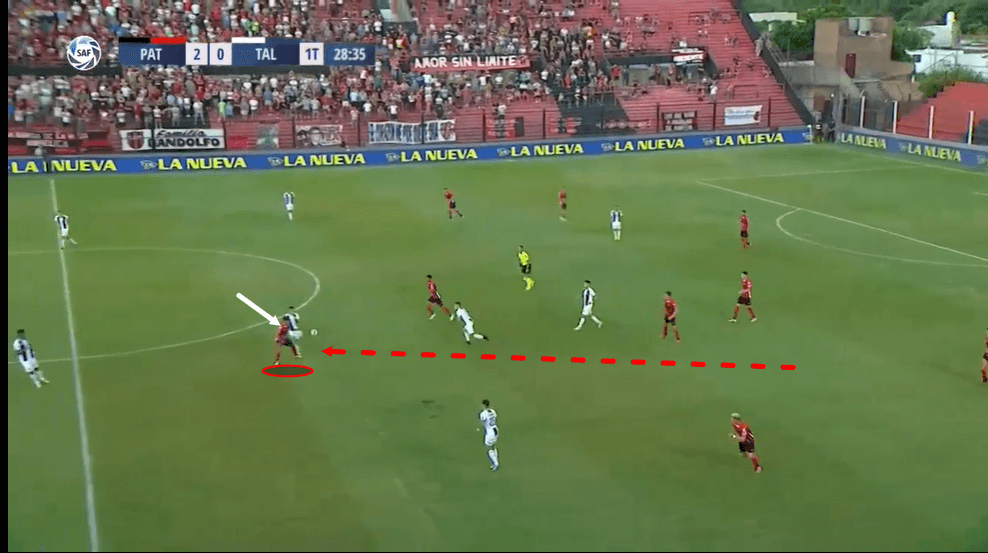
The image above provides us with an example of the midfielder making a ball recovery in the middle of the park – the kind of position that Nîmes like to make many of their ball recoveries.
On this occasion, Cubas occupied the position just in front of the centre-backs while his side tried to break down the opposition, however, Talleres’ attack broke down inside the final third and this allowed the opposition to try and spring a counter-attack. As the opposition attempted to counter, they sent the ball up to their centre forward, however, as we mentioned previously, Cubas is quick, as well as being aggressive and as the ball gets played up to the attacker here, he manages to shift his position from a more central part of the midfield over to this would-be ball-receiver.
He gets ahead of the opposition attacker, cutting out the pass and subsequently starting back up a counter-attack of his own from a fairly dangerous position. This passage of play indicates his anticipation and aggression, as well as some of his technical ability both on and off the ball, as he intercepts the ball and quickly starts a counter-attack.
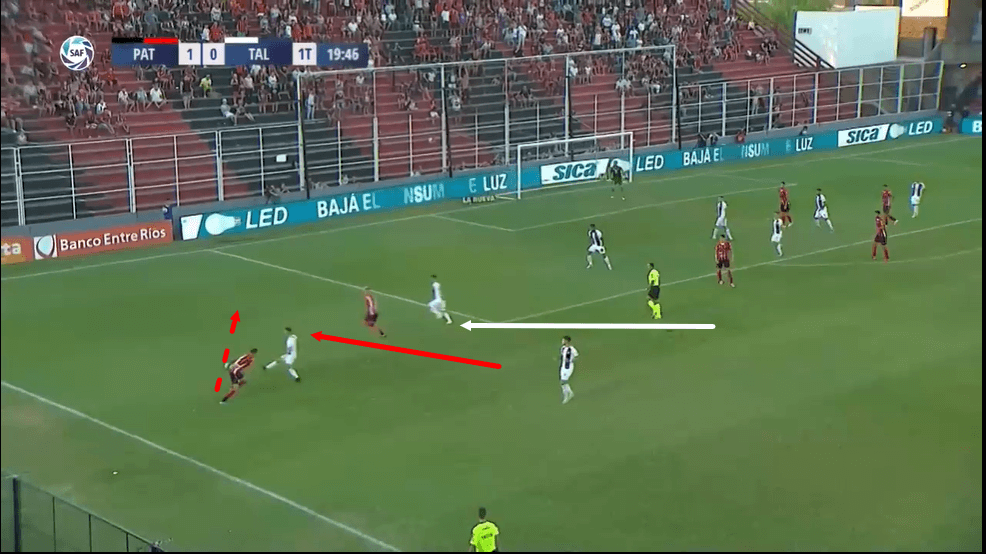
While in the previous example we saw Cubas defending fairly high up the pitch, this next image provides us with an example of the midfielder defending in a deeper area of the pitch. As we can see, the opposition winger has just played a ball through to an advancing midfielder here. While the winger combines well with the midfielder to beat the Talleres full-back, Cubas displays his intelligent reading of the game, as well as his speed, once again, to track this opposition midfielder’s run from the centre of the pitch out to the wide-area – preventing his teammate from getting outnumbered on the wing.
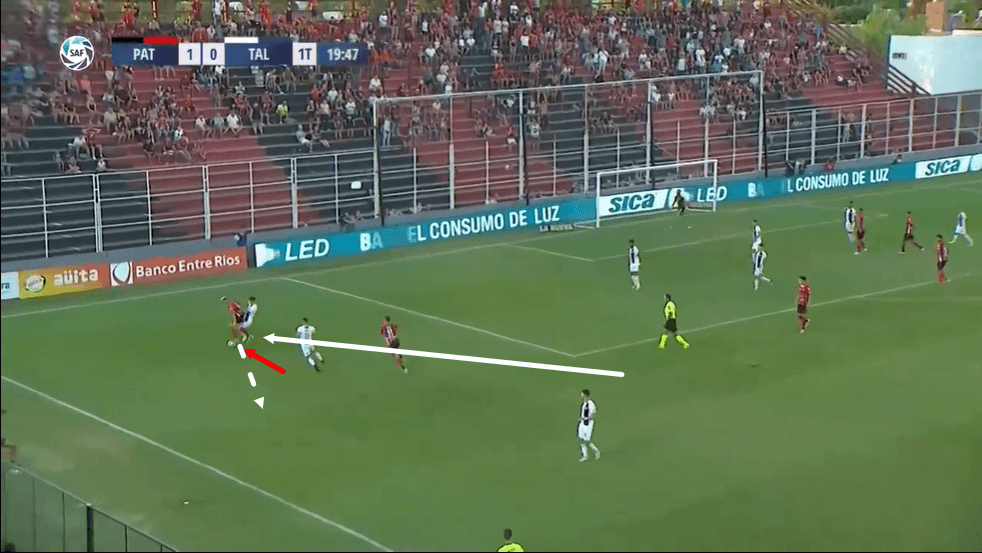
As play moves on, we see that while the intended recipient of this pass does initially take possession of the ball, he is quickly dispossessed by the aggressive Cubas who sends the ball up the pitch and out of danger for Talleres.
This passage of play shows us another side of Cubas’ defensive game – his ability to defend in deeper positions. As Nîmes have been a non-possession-based side in Ligue 1 since earning promotion to France’s top-flight two years ago, Cubas may have plenty of defending to do in this part of the pitch as well as in the middle of the park and he has shown that he is more than capable of performing effectively in those areas without the ball.
Additionally, in both of these passages of play, after winning the ball back, Cubas was quick to get his head up and advance the ball up the pitch. He is generally good at getting his head up quickly and playing progressive passes after receiving possession or winning the ball without spending too much time on the ball, which is a trait of his that may serve him well at Nîmes.
Cubas’ passing ability
Cubas proved himself to be a good progressive passer during his time at Talleres. During the 2019/20 Argentina Superliga season, he played an impressive 7.13 passes into the final third per 90, with a 68.24% success rate.
Cubas played more passes into the final third per 90 than all but four other Talleres players during the 2019/20 campaign.
The Paraguay midfielder also played an average of 16.24 forward passes per 90 during the 2019/20 season, with a 73.4% success rate.
These stats indicate that Cubas is good at advancing the ball forward and progressing the play, which is particularly important for Nimes’ midfielders, as we touched on previously, due to the team’s tendency to rely heavily on the midfielders in the transition from defence to attack.
However, we also stated previously that Nimes’ deep central midfielders are sometimes required to play the final ball due to the fact that they often play against a high line as they are generally quite happy to give up the majority of the possession.
Cubas has shown a good level of vision to spot defence-splitting passes during his career and he has shown a willingness to attempt them, however, as of yet, this isn’t an area that the midfielder thrives in.
Cubas played 0.67 through passes per 90 in the 2019/20 Argentina Superliga campaign, with a success rate of just 14.29%. A total of 13 other Talleres players made more through pass attempts than Cubas did during the 2019/20 league season, and all of them had a better accuracy percentage than the newly-signed Nimes man as well.
With that in mind, it may be fair to say that his ability to play the final ball is an area in which Cubas does have plenty of room for improvement.
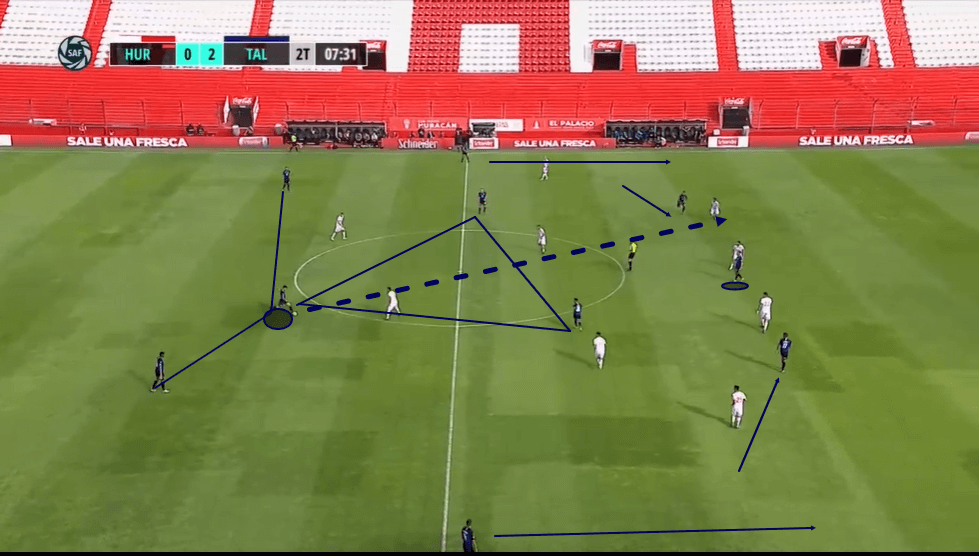
The image above shows us Cubas playing the sole-holding midfield role for Talleres. At this moment, we see him dropping deep and splitting the centre-backs, allowing the wing-backs to push high and the wingers to cut inside, forming something of a 3-4-3 shape in possession.
Cubas enjoys occupying this deep-lying playmaker position as he can enjoy a larger field of view from where he can pick out his long passes and progress play quickly thanks to his progressive passing ability.
Here, the midfielder drops deep in between the centre-backs and subsequently launches a long-ball forward, spotting the run of one of his side’s attackers from a much deeper position. This passage of play indicates how useful of a tool, in terms of progressing play, Cubas’ positioning, vision and long passing quality can be for Nimes.
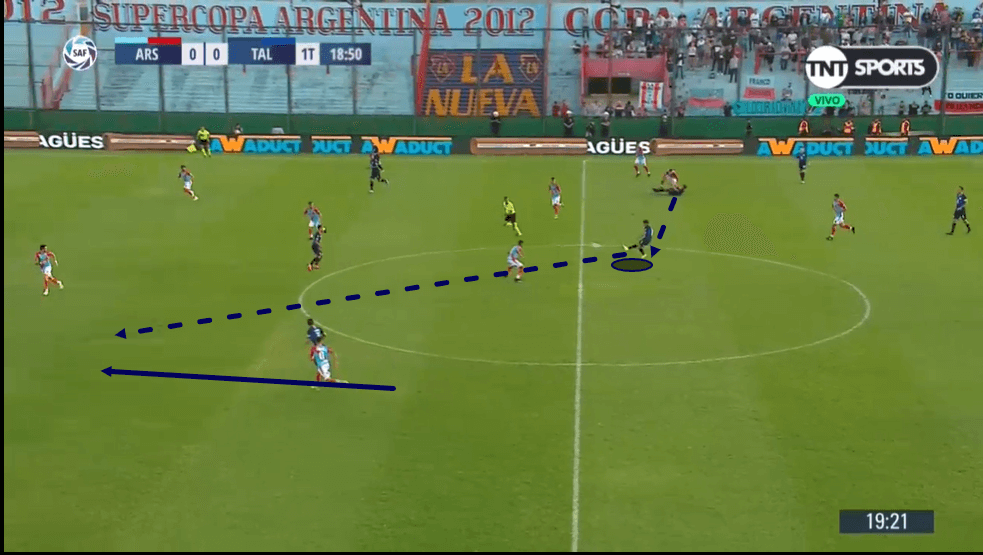
This next image is taken just after Talleres won back possession of the ball in the middle of the park. The ball-winner retrieved possession and subsequently played the ball inside to Cubas. As we touched on previously, Cubas isn’t one to take his time on the ball, particularly in a situation like this where he is being pressed and a counter-attacking opportunity has emerged. Instead, he prefers to get his head up immediately and try to play a defence-splitting ball.
On this particular occasion, Cubas’ lack of accuracy when it comes to playing through passes comes to the fore and the midfielder’s pass is quite easily intercepted by an opposition player after he put a bit too much power on the ball. However, once again, this provides us with an example of Cubas’ vision and willingness to quickly progress the ball from deep into the final third.
Conclusion
To conclude this tactical analysis piece, we believe that Cubas is a very good fit for Nimes, particularly in terms of his off-the-ball quality. He is an aggressive, pacey and intelligent player off the ball and those traits may translate well to what is likely to be required of him at Nimes, judging by Les Crocodiles’ Ligue 1 performances over the last two campaigns.
Cubas also has plenty of quality on the ball and likes to utilise his long-ball playing ability, however, there are aspects of his playmaking ability that he could do with improving upon at Nimes.


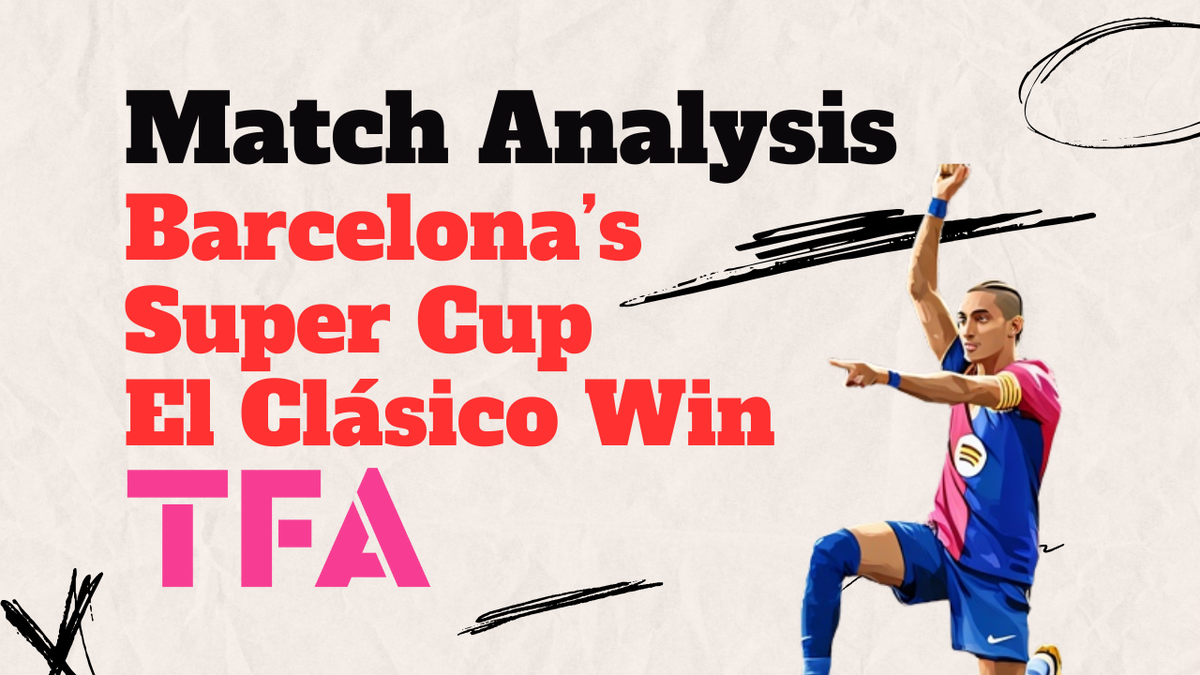
Comments